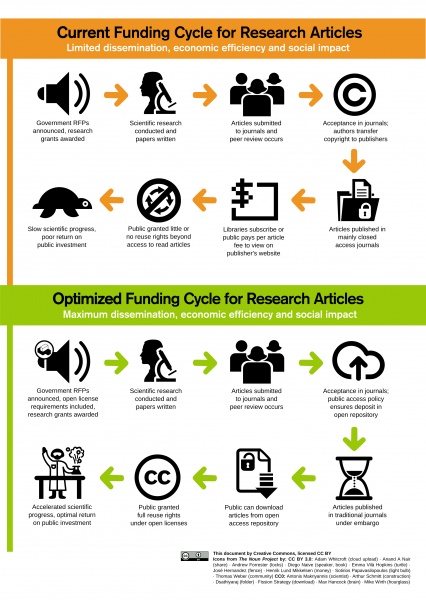Open Access
In 2002, the Budapest Open Access Initiative articulated the basic tenets of Open Access for the first time. Since then, thousands of journals have adopted policies that embrace some or all of the Open Access core components related to: readership, reuse, copyright, posting, and machine readability. However, not all Open Access is created equal. For example, a policy that allows anyone to read an article for free six months after its publication is more open than a policy that creates a twelve month embargo; it is also less open than a policy that allows for free reading immediately upon publication.
This guide will help you move beyond the seemingly simple question, “Is this journal open access?” and toward a more productive alternative, “How open is it?” A Guide For Evaluating the Openness of Journals
Use it to:
• Understand the components that define Open Access
• Learn what makes a journal more open vs. less open
• Make informed decisions about where to publish
Open Access is . . .
If an article is "Open Access" it means that it can be freely accessed by anyone in the world using an internet connection. This means that the potential readership of Open Access articles is far, far greater than that for articles where the full-text is restricted to subscribers. Evidence shows that making research material Open Access increases the number of readers and significantly increases citations to the article - in some fields increasing citations by 300%.
What Open Access is not
It is important to point out that Open Access does not affect peer-review; articles are peer-reviewed and published in journals in the normal way. There is no suggestion that authors should use repositories instead of journals. Open Access repositories supplement and do not replace journals. Some authors have feared that wider availability will increase plagiarism: in fact, if anything, Open Access serves to reduce plagiarism. When material is freely available the chance that plagiarism is recognised and exposed is that much higher.
http://www.sherpa.ac.uk/guidance/authors.html
|
A Closed Research Model vs An Open Education Model Image from https://creativecommons.org/2013/09/25/public-access-to-publicly-funded-materials-what-could-be/ by Timothy Vollmer and Teresa Sempere García |
Open Access benefits researchers, institutions, nations and society as a whole. For researchers, it brings increased visibility, usage and impact for their work. Institutions enjoy the same benefits in aggregated form. There is growing evidence to show that countries also benefit because Open Access increases the impact of the research in which they invest public money and therefore there is a better return on investment. Society as a whole benefits because research is more efficient and more effective, delivering better and faster outcomes for us all. Open Access is the alternative to Closed Access (or Subscription Access or Toll Access)... Now, in the age of the World Wide Web, it is possible for research findings to be disseminated free of charge to anyone who wishes to read them... Repositories can provide usage data to show the number of times articles have been downloaded... Developing country repositories also enjoy a high level of usage of repositories, which are at last providing to the rest of the world the outputs from scholars in those countries who previously had difficulty publishing in 'western' journals... For details OASIS (Open Access Scholarly Information Sourcebook) by Alma Swan and Leslie Chan |
Society as a whole benefits from an expanded and accelerated research cycle in which research can advance more effectively because researchers have immediate access to all the findings they need.
The visibility, usage and impact of researchers' own findings increases with OA, as does their power to find, access and use the findings of others. Universities co-benefit from their researchers' increased impact, which also increases the return on the investment of the funders of the research, such as governments, charitable foundations, and the tax-paying public.
For teachers, Open Access means no restrictions on providing articles for teaching purposes. Only the URL need be provided; Open Access takes care of the rest. Publishers likewise also benefit from the wider dissemination, greater visibility and higher journal citation impact factor of their articles.
http://www.eprints.org/openaccess/
- The author is the copyright holder. As the author of a work you are the copyright holder unless and until you transfer the copyright to someone else in a signed agreement
- Assigning your rights matters. Normally, the copyright holder possesses the exclusive rights of reproduction, distribution, public performance, public display, and modification of the original work. An author who has transferred copyright without retaining these rights must ask permission unless the use is one of the statutory exemptions in copyright law.
- The copyright holder controls the work. Decisions concerning use of the work, such as distribution, access, pricing, updates, and any use restrictions belong to the copyright holder. Authors who have transferred their copyright without retaining any rights may not be able to place the work on course Web sites, copy it for students or colleagues, deposit the work in a public online archive, or reuse portions in a subsequent work. That’s why it is important to retain the rights you need.
For further information The SPARC Author Addendum
About SPARC
- Archnet
- DergiPark
- DOAB - Directory of Open Access Books
- DOAJ - Directory of Open Access Journals
- Driver - Digital Repository Infrastructure Vision for European Research
- Espacenet
- Genamics JournalSeek
- J-Stage
- National Academies Press
- OAIster
- Open Library
- OpenDOAR - Directory of Open Access Repositories
- The New York Public Library Digital Collections
- The Online Books Page
- World Bank Data Catalog
Use the following sources to pick reliable and high quality Open Access journals:
- DOAJ (Directory of Open Access Journals) to find OA journals that exercise peer-review or editorial control. DOAJ has tightened the listing criteria.
- InCites
- Journal Citation Reports 1997-2018
- Scopus

